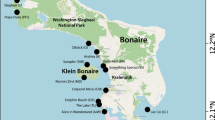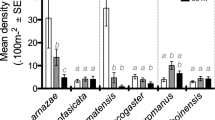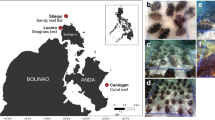Abstract
Within tropical coastal habitats such as coral reefs and seagrass meadows, sea anemones (Actiniaria) provide microhabitats for a diverse range of fauna. However, the mechanisms that enable these interactions, and how actiniarian diversity and abundance mediates associate assemblages, remains poorly understood. Here, we compared sea anemone species richness and abundance with that of their associated decapod crustaceans and teleost fishes across adjacent coral reef and seagrass habitats at Carrie Bow Cay, Belize. At least 16 decapod and seven fish species were associated with anemones across both habitats, including several previously undocumented associations. While overall anemone-associate richness did not differ between habitats, seagrass anemones had the greatest mean abundance and diversity of both decapod and fish associates. This suggests that the importance of anemones as microhabitat reflected broader benthic complexity and shelter availability, with species aggregating on sea anemones when access to alternative shelter, such as corals, was limited. Patterns of associate distributions on anemones were also highly structured, in terms of both associate and anemone species, with these patterns likely reflecting a combination of associate specialization, intraspecific competition, and anemone morphology and toxicity. The diverse multi-species associate complexes observed suggest that sea anemones provide an important refuge for both specialized and generalist species and so have the potential to increase faunal diversity and abundance within tropical coastal habitats.


Similar content being viewed by others
References
Almany GR (2004) Does increased habitat complexity reduce predation and competition in coral reef fish assemblages? Oikos 106:275–284
Baeza JA, Stotz WB (2001) Host-use pattern and host-selection during ontogeny of the commensal crab Allopetrolisthes spinifrons (H. Milne Edwards, 1837) (Decapoda: Anomura: Porcellanidae). J Nat Nist 35:341–355
Beck MW, Brumbaugh RD, Airoldi L, Carranza A, Coen LD, Crawford C, Defeo O, Edgar GJ, Hancock B, Kay MC, Lenihan HS, Luckenbach MW, Toropova CL, Zhang G, Guo X (2011) Oyster reefs at risk and recommendations for conservation, restoration, and management. Bioscience 61:107–116
Bell JJ (2008) The functional roles of marine sponges. Estuar Coast Shelf Sci 79:341–353
Bell JJ, Davy SK, Jones T, Taylor MW, Webster NS (2013) Could some coral reefs become sponge reefs as our climate changes? Glob Chang Biol 19:2613–2624
Bos AR, Hoeksema BW (2015) Cryptobenthic fishes and co-inhabiting shrimps associated with the mushroom coral Heliofungia actiniformis (Fungiidae) in the Davao Gulf, Philippines. Environ Biol Fish 98:1479–1489
Briones-Fourzán P, Pérez-Ortiz M, Negrete-Soto F, Barradas-Ortiz C, Lozano-Álvarez E (2012) Ecological traits of Caribbean sea anemones and symbiotic crustaceans. Mar Ecol Prog Ser 470:55–68
Camp EF, Hobbs JP, De Brauwer M, Dumbrell AJ, Smith DJ (2016) Cohabitation promotes high diversity of clownfishes in the Coral Triangle. Proc R Soc B Biol Sci 283:20160277
Caves EM, Green PA, Johnsen S (2018) Mutual visual signalling between the cleaner shrimp Ancylomenes pedersoni and its client fish. Proc R Soc B Biol Sci 285:20180800
Chadwick NE, Ďuriš Z, Horká I (2008) Biodiversity and behavior of shrimps and fishes symbiotic with sea anemones in the Gulf of Aqaba, northern Red Sea. In: Por FD (ed) The improbable gulf: history, biodiversity, and protection of the Gulf of Aqaba (Eilat). Magnes Press, Jerusalem, pp 209–223
Chapuis L, Bshary R (2010) Signalling by the cleaner shrimp Periclimenes longicarpus. Anim Behav 79:645–647
Chesson P (2000) Mechanisms of maintenance of species diversity. Annu Rev Ecol Syst 31:343–366
Coker DJ, Wilson SK, Pratchett MS (2014) Importance of live coral habitat for reef fishes. Rev Fish Biol Fish 24:89–126
Colombara AM, Quinn D, Chadwick NE (2017) Habitat segregation and population structure of Caribbean sea anemones and associated crustaceans on coral reefs at Akumal Bay, Mexico. Bull Mar Sci 93:1025–1047
Crawford JA (1992) Acclimation of the shrimp, Periclimenes anthophilus, to the giant sea anemone, Condylactis gigantea. Bull Mar Sci 50:331–341
Dixon AK, McVay MJ, Chadwick NE (2017) Demographic modelling of giant sea anemones: population stability and effects of mutualistic anemonefish in the Jordanian Red Sea. Mar Freshw Res 68:2145–2155
Duke NC, Meynecke J-O, Dittmann S, Ellison AM, Anger K, Berger U, Cannicci S, Diele K, Ewel KC, Field CD, Koedam N, Lee SY, Marchand C, Nordhaus I, Dahdouh-Guebas F (2007) A world without mangroves? Science 317:41–42
Elliot JK, Mariscal RN (2001) Coexistence of nine anemonefish species: differential host and habitat utilization, size and recruitment. Mar Biol 138:23–36
Fautin DG (1991) The anemonefish symbiosis: what is known and what is not. Symbiosis 10:23–46
Fautin DG, Malarky L, Soberón J (2013) Latitudinal diversity of sea anemones (Cnidaria: Actiniaria). Biol Bull 224:89–98
Feeney WE, Brooker RM (2016) Anemonefishes. Curr Biol 27:R6–R8
Feeney WE, Brooker RM, Johnston LN, Gilbert JDJ, Besson M, Lecchini D, Dixson DL, Cowman PF, Manica A (2019) Predation drives recurrent convergence of an interspecies mutualism. Ecol Lett 22:256–264
Gillies CL, McLeod IM, Alleway HK, Cook P, Crawford C, Creighton C, Diggles B, Ford J, Hamer P, Heller-Wagner G, Lebrault E, Le Port A, Russell K, Sheaves M, Warnock B (2018) Australian shellfish ecosystems: past distribution, current status and future direction. PLoS One 13:e0190914
Goh NKC, Ng PKL, Chou LM (1999) Notes on the shallow water gorgonian-associated fauna on coral reefs in Singapore. Bull Mar Sci 65:259–282
González-Muñoz R, Simões N, Sanchez-Rodriguez J, Rodriguez E, Segura-Puertas L (2012) First inventory of sea anemones (Cnidaria: Actiniaria) of the Mexican Caribbean. Zootaxa 3556:1–38
Grutter AS (2004) Cleaner fish use tactile dancing behavior as a preconflict management strategy. Curr Biol 14:1080–1083
Grutter AS, Feeney WE (2016) Equivalent cleaning in a juvenile facultative and obligate cleaning wrasse: an insight into the evolution of cleaning in labrids? Coral Reefs 35:991–997
Gutiérrez JL, Jones CG, Strayer DL, Iribarne OO (2003) Mollusks as ecosystem engineers: the role of shell production in aquatic habitats. Oikos 101:79–90
Hanlon RT, Hixon RF (1983) Behavioural associations of coral reef fishes with the sea anemone Condylactis gigantea in the Dry Tortugas, Florida. Bull Mar Sci 39:130–134
Harborne A (2000) Fish and coral species lists compiled by Coral Cay Conservation: Belize 1990–1998. Coral Cay Conservation, London, England
Hayes FE, Trimm NA (2008) Distributional ecology of the anemone shrimp Periclimenes rathbunae associating with the sea anemone Stichodactyla helianthus at Tobago, West Indies. Nauplius 16:73–77
Hiller A, Kraus H, Almon M, Werding B (2006) The Petrolisthes galathinus complex: species boundaries based on color pattern, morphology and molecules, and evolutionary interrelationships between this complex and other Porcellanidae (Crustacea: Decapoda: Anomura). Mol Phylogenet Evol 40:547–569
Hoeksema BW, van der Meij SET, Fransen CHJM (2012) The mushroom coral as a habitat. J Mar Biol Assoc U K 92:647–663
Holbrook SJ, Schmitt RJ (2005) Growth, reproduction and survival of a tropical sea anemone (Actiniaria): benefits of hosting anemonefish. Coral Reefs 24:67–73
Huebner LK, Chadwick NE (2012) Reef fishes use sea anemones as visual cues for cleaning interactions with shrimp. J Exp Mar Biol Ecol 416–417:237–242
Huebner LK, Dailey B, Titus BM, Khalaf M, Chadwick NE (2012) Host preference and habitat segregation among Red Sea anemonefish: effects of sea anemone traits and fish life stages. Mar Ecol Prog Ser 464:1–15
Hughes TP, Kerry JT, Álvarez-Noriega M, Álvarez-Romero JG, Anderson KD, Baird AH, Babcock RC, Beger M, Bellwood DR, Berkelmans R, Bridge TC, Butler IR, Byrne M, Cantin NE, Comeau S, Connolly SR, Cumming GS, Dalton SJ, Diaz-Pulido G, Eakin CM, Figueira WF, Gilmour JP, Harrison HB, Heron SF, Hoey AS, Hobbs J-PA, Hoogenboom MO, Kennedy EV, Kuo C, Lough JM, Lowe RJ, Liu G, McCulloch MT, Malcolm HA, McWilliam MJ, Pandolfi JM, Pears RJ, Pratchett MS, Schoepf V, Simpson T, Skirving WJ, Sommer B, Torda G, Wachenfeld DR, Willis BL, Wilson SK (2017) Global warming and recurrent mass bleaching of corals. Nature 543:373–377
Hughes TP, Kerry JT, Baird AH, Connolly SR, Dietzel A, Eakin CM, Heron SF, Hoey AS, Hoogenboom MO, Liu G, McWilliam MJ, Pears RJ, Pratchett MS, Skirving WJ, Stella JS, Torda G (2018) Global warming transforms coral reef assemblages. Nature 556:492–496
Humann P, Deloach N, Wilk L (2013) Reef creature identification: Florida, Caribbean, Bahamas, 3rd edn. New World Publications, Florida
Hurt C, Silliman K, Anker A, Knowlton N (2013) Ecological speciation in anemone-associated snapping shrimps (Alpheus armatus species complex). Mol Ecol 22:4532–4548
Jones CG, Lawton JH, Shachak M (1994) Organisms as ecosystem engineers. Oikos 69:373–386
Khan RN, Becker JH, Crowther AL, Lawn ID (2003) Sea anemone host selection by the symbiotic saddled cleaner shrimp Periclimenes holthuisi. Mar Freshw Res 54:653–656
Khan RN, Becker JH, Crowther AL, Lawn ID (2004) Spatial distribution of symbiotic shrimps (Periclimenes holthuisi, P. brevicarpalis, Thor amboinensis) on the sea anemone Stichodactyla haddoni. J Mar Biol Assoc UK 84:201–203
Lima SL, Dill LM (1990) Behavioral decisions made under the risk of predation: a review and prospectus. Can J Zool 68:619–640
McCammon AM, Brooks WR (2014) Protection of host anemones by snapping shrimps: a case for symbiotic mutualism? Symbiosis 63:71–78
McCammon AM, Sikkel PC, Nemeth D (2010) Effects of three Caribbean cleaner shrimps on ectoparasitic monogeneans in a semi-natural environment. Coral Reefs 29:419–426
McKeon CS, O’Donnell JL (2015) Variation in partner benefits in a shrimp-sea anemone symbiosis. PeerJ 3:e1409
McLeod IM, Parsons DM, Morrison MA, Van Dijken SG, Taylor RB (2014) Mussel reefs on soft sediments: a severely reduced but important habitat for macroinvertebrates and fishes in New Zealand. N Z J Mar Freshw Res 48:48–59
Mebs D (2009) Chemical biology of the mutualistic relationships of sea anemones with fish and crustaceans. Toxicon 54:1071–1074
Neo ML, Eckman W, Vicentuan K, Teo SL-M, Todd PA (2015) The ecological significance of giant clams in coral reef ecosystems. Biol Conserv 181:111–123
O’Reilly EE, Chadwick NE (2017) Population dynamics of corkscrew sea anemones Bartholomea annulata in the Florida Keys. Mar Ecol Prog Ser 567:109–123
O’Reilly E, Titus BM, Nelsen MW, Ratchford S, Chadwick NE (2018) Giant ephemeral anemones? Rapid growth and high mortality of corkscrew sea anemones Bartholomea annulata (Le Sueur, 1817) under variable conditions. J Exp Mar Biol Ecol 509:44–53
Porat D, Chadwick-Furman NE (2004) Effects of anemonefish on giant sea anemones: expansion behavior, growth and survival. Hydrobiologia 530:513–520
Randall JE, Fautin DG (2002) Fishes other than anemonefishes that associate with anemones. Coral Reefs 21:188–190
Ritson-Williams R, Paul VJ (2007) Periclimenes yucatanicus and Periclimenes rathbunae on unusual corallimorph hosts. Coral Reefs 26:147
Robertson DR, Polunin NVC (1981) Coexistence: symbiotic sharing of feeding territories and algal food by some coral reef fishes from the Western Indian Ocean. Mar Biol 62:185–195
Roopen M, Chadwick NE (2009) Benefits to host sea anemones from ammonia contributions of resident anemonefish. J Exp Mar Biol Ecol 370:27–34
Sheridan NE, Fautin DG, Garrett MJ (2015) Gametogenesis and reproductive periodicity of the “biologically vulnerable” giant Caribbean sea anemone, Condylactis gigantea, in Florida. Invertebr Biol 134:116–128
Silbiger NJ, Childress MJ (2008) Interspecific variation in anemone shrimp distribution and host selection in the Florida Keys (USA): implications for marine conservation. Bull Mar Sci 83:329–345
Spotte S (1996) Supply of regenerated nitrogen to sea anemones by their symbiotic shrimp. J Exp Mar Biol Ecol 198:27–36
Stella J, Pratchett M, Hutchings P, Jones G (2011) Coral-associated invertebrates: diversity, ecological importance and vulnerability to disturbance. Oceanogr Mar Biol Annu Rev 49:43–104
Szczebak JT, Henry RP, Al-Horani FA, Chadwick NE (2013) Anemonefish oxygenate their anemone hosts at night. J Exp Biol 216:970–976
Tews J, Brose U, Grimm V, Tielbörger K, Wichmann MC, Schwager M, Jeltsch F (2004) Animal species diversity driven by habitat heterogeneity/diversity: the importance of keystone structures. J Biogeogr 31:79–92
Titus BM, Daly M, Exton DA (2015) Temporal patterns of Pederson shrimp (Ancylomenes pedersoni Chace 1958) cleaning interactions on Caribbean coral reefs. Mar Biol 162:1651–1664
Titus BM, Daly M, Macrander J, Del Rio A, Santos SR, Chadwick NE (2017a) Contrasting abundance and contribution of clonal proliferation to the population structure of the corkscrew sea anemone Bartholomea annulata in the tropical Western Atlantic. Invertebr Biol 136:62–74
Titus BM, Vondriska C, Daly M (2017b) Comparative behavioural observations demonstrate the ‘cleaner’ shrimp Periclimenes yucatanicus engages in true symbiotic cleaning interactions. R Soc Open Sci 4:170078
Vaughan DB, Grutter AS, Costello MJ, Hutson KS (2016) Cleaner fishes and shrimp diversity and a re-evaluation of cleaning symbioses. Fish Fish 18:698–716
WoRMS Editorial Board (2019) World Register of Marine Species. Available from http://www.marinespecies.org at VLIZ. Accessed 4 Jan 2019
Wulff JL (2006) Ecological interactions of marine sponges. Can J Zool 84:146–166
Acknowledgments
We would like to thank the editor and three anonymous reviewers for their comments and suggestions on this manuscript. Thanks to the Smithsonian Institution and the Carrie Bow Cay Field Station, Z. Foltz, S & J Alanko, Z-L Cowan, and D Dixson for assistance and logistical support. Permission to conduct this study was granted under Marine Science Research Permit 0009-18, issued by the Belize Fisheries Department. This manuscript represents CCRE contribution 1025.
Funding
This work was supported by National Geographic Explorer Grant to RMB (9860-16).
Author information
Authors and Affiliations
Corresponding author
Ethics declarations
Conflict of interest
The authors declare that they have no conflict of interest.
Ethical approval
All applicable international, national, and/or institutional guidelines for the care and use of animals were followed by the authors.
Sampling and field studies
All necessary permits for sampling and observational field studies have been obtained by the authors from the competent authorities and are mentioned in the acknowledgements, if applicable.
Data availability
The datasets generated during and/or analyzed during the current study are available from the corresponding author on reasonable request.
Additional information
Communicated by B. W. Hoeksema
Publisher’s note
Springer Nature remains neutral with regard to jurisdictional claims in published maps and institutional affiliations.
Rights and permissions
About this article
Cite this article
Brooker, R.M., Feeney, W.E., Sih, T.L. et al. Comparative diversity of anemone-associated fishes and decapod crustaceans in a Belizean coral reef and seagrass system. Mar. Biodivers. 49, 2609–2620 (2019). https://doi.org/10.1007/s12526-019-00993-5
Received:
Revised:
Accepted:
Published:
Issue Date:
DOI: https://doi.org/10.1007/s12526-019-00993-5




